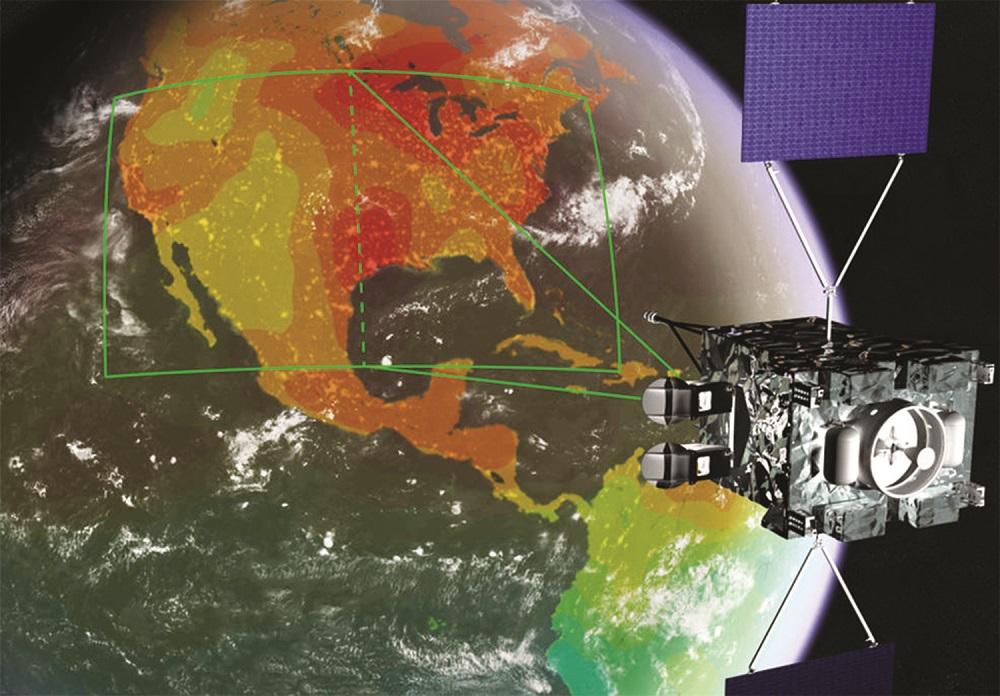Seismic observations have recently revealed two seismic anomalies in Earth’s lowermost mantle, one beneath Africa and the other beneath the Pacific Ocean, named large low-shear-wave-velocity provinces (LLSVPs). These blob-like structures are each the size of a continent and 100 times taller than Mt. Everest. Geoscientists know that these two LLSVPs have very complicated shapes and structures, but despite their prominent features, little is known about why these structures exist or what led to their odd shapes.
Locations of four vertical cross sections (thick, solid lines) on two LLSVPs (yellow). Image credit: Yuan & Li, doi: 10.1038/s41561-022-00908-3.
“Understanding Earth’s deep mantle structure, dynamics and evolution remains one of the most challenging and important tasks in solid Earth sciences,” said Arizona State University scientists Qian Yuan and Mingming Li.
“The LLSVPs are the largest contiguous structures in Earth’s mantle and they considerably impact surface volcanism, deep mantle convection and core heat flux that is responsible for dynamo.”
“However, it remains unclear what causes the LLSVPs and how they interact with the surrounding mantle.”
“Deciphering the origin and dynamics of the LLSVPs requires a better understanding of the physical properties of the LLSVPs, particularly their density and viscosity differences with the surrounding mantle.”
“However, deep mantle density and viscosity are not well resolved, which inhibits fully comprehending the origin and dynamics of LLSVPs.”
“Importantly, the morphology of the LLSVPs is an expression of their interaction with the surrounding mantle dynamics, which is controlled by and thus provides information on the deep mantle density and viscosity structures.”
In the new research, Dr. Yuan and Dr. Li aimed to learn more about these two LLSVPs using geodynamic modeling and analyses of published seismic studies.
They were able to determine the maximum heights that the blobs reach and how their volume and density, as well as the surrounding viscosity in the mantle, might control their height.
The results of their seismic analysis led to a surprising discovery that the blob under the African continent is about 1,000 km (621 miles) higher than the blob under the Pacific Ocean.
The best explanation for the vast height difference between the two is that the African LLSVP is less dense — and therefore less stable — than the one under the Pacific Ocean.
In their study, the authors designed and ran hundreds of mantle convection models simulations.
They tested the effects of key factors that may affect the height of the blobs, including the volume of the blobs and the contrasts of density and viscosity of the blobs compared with their surroundings.
They found that to explain the large differences of height between the two blobs, the one under the African continent must be of a lower density than that of the blob under the Pacific Ocean, indicating that the two may have different composition and evolution.
“Our calculations found that the initial volume of the blobs does not affect their height,” Dr. Yuan said.
“The height of the blobs is mostly controlled by how dense they are and the viscosity of the surrounding mantle.”
“The African LLVP may have been rising in recent geological time,” Dr. Li added.
“This may explain the elevating surface topography and intense volcanism in eastern Africa.”
The ream’s findings may fundamentally change the way geoscientists think about the deep mantle processes and how they can affect the surface of the Earth.
The unstable nature of the African LLVP, for example, may be related to continental changes in topography, gravity, surface volcanism and plate motion.
“Our combination of the analysis of seismic results and the geodynamic modeling provides new insights on the nature of the Earth’s largest structures in the deep interior and their interaction with the surrounding mantle,” Dr. Yuan said.
“This work has far-reaching implications for scientists trying to understand the present-day status and the evolution of the deep mantle structure, and the nature of mantle convection.”
The team’s paper was published in the journal Nature Geoscience.
_____
Q. Yuan & M. Li. Instability of the African large low-shear-wave-velocity province due to its low intrinsic density. Nat. Geosci, published online March 10, 2022; doi: 10.1038/s41561-022-00908-3
Note: This article have been indexed to our site. We do not claim legitimacy, ownership or copyright of any of the content above. To see the article at original source Click Here














